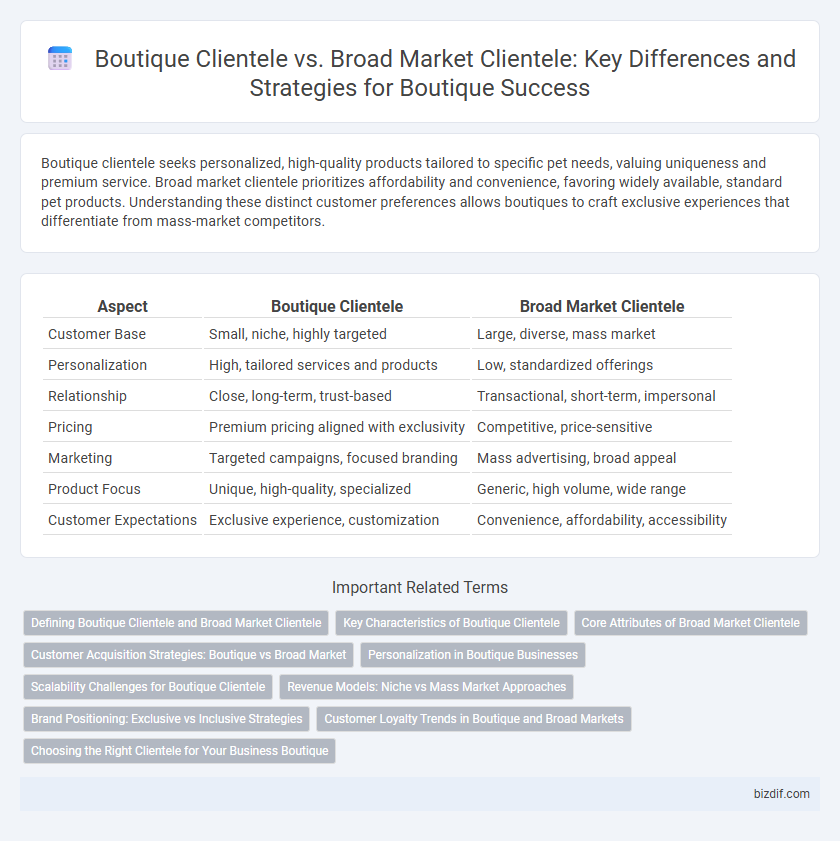Boutique clientele seeks personalized, high-quality products tailored to specific pet needs, valuing uniqueness and premium service. Broad market clientele prioritizes affordability and convenience, favoring widely available, standard pet products. Understanding these distinct customer preferences allows boutiques to craft exclusive experiences that differentiate from mass-market competitors.
Table of Comparison
| Aspect | Boutique Clientele | Broad Market Clientele |
|---|---|---|
| Customer Base | Small, niche, highly targeted | Large, diverse, mass market |
| Personalization | High, tailored services and products | Low, standardized offerings |
| Relationship | Close, long-term, trust-based | Transactional, short-term, impersonal |
| Pricing | Premium pricing aligned with exclusivity | Competitive, price-sensitive |
| Marketing | Targeted campaigns, focused branding | Mass advertising, broad appeal |
| Product Focus | Unique, high-quality, specialized | Generic, high volume, wide range |
| Customer Expectations | Exclusive experience, customization | Convenience, affordability, accessibility |
Defining Boutique Clientele and Broad Market Clientele
Boutique clientele consists of a select group of discerning customers seeking personalized services and exclusive, high-quality products tailored to their unique preferences. Broad market clientele encompasses a wide, diverse audience prioritizing accessibility, affordability, and mass appeal across various demographics. Understanding the distinct needs and expectations of boutique versus broad market clientele enables businesses to effectively customize marketing strategies and product offerings.
Key Characteristics of Boutique Clientele
Boutique clientele typically consists of discerning customers who prioritize personalized service, exclusive product offerings, and unique shopping experiences. These clients often value quality over quantity, seeking tailored solutions that reflect their individual tastes and preferences. Unlike broad market clientele, boutique customers are more likely to form long-term brand loyalty due to the intimate and customized engagement.
Core Attributes of Broad Market Clientele
Broad market clientele is characterized by diverse demographics, encompassing various age groups, income levels, and cultural backgrounds, which demands products and services with broad appeal and adaptability. This segment prioritizes convenience, competitive pricing, and widespread availability over exclusivity and niche specialization. Businesses targeting broad market clientele invest heavily in scalable marketing strategies and efficient supply chains to meet high demand and maintain customer satisfaction across a wide audience.
Customer Acquisition Strategies: Boutique vs Broad Market
Boutique customer acquisition strategies focus on personalized marketing, targeted niche campaigns, and cultivating strong relationships through exclusive experiences and tailored services. Broad market strategies emphasize mass advertising, scalable promotions, and widespread brand visibility to attract diverse consumer segments. Boutique brands leverage detailed customer insights and high-touch engagement, while broad market approaches prioritize reach and volume for rapid customer growth.
Personalization in Boutique Businesses
Boutique businesses excel in offering personalized services tailored to niche clientele, enhancing customer loyalty and satisfaction through bespoke experiences. Unlike broad market businesses that cater to diverse customer bases with standardized products, boutiques leverage intimate client relationships and detailed understanding of individual preferences. This personalized approach drives higher perceived value, enabling boutiques to differentiate themselves in competitive markets.
Scalability Challenges for Boutique Clientele
Boutique clientele demand highly personalized services and unique product offerings, limiting the ability to scale operations efficiently compared to broad market clientele. The intensive customization required for boutique clients often results in higher costs and resource allocation, creating barriers to rapid expansion. Scalability challenges arise from maintaining exclusivity and quality while attempting to grow the client base without diluting the brand value.
Revenue Models: Niche vs Mass Market Approaches
Boutique businesses serve a niche clientele by offering specialized products or services that command higher prices, resulting in higher profit margins per customer. Revenue models in boutique settings focus on exclusivity and personalized experiences, driving customer loyalty and repeat purchases within a targeted segment. Mass market approaches prioritize volume sales and standardized offerings, generating revenue through broader customer bases but often at lower profit margins per unit.
Brand Positioning: Exclusive vs Inclusive Strategies
Boutique clientele typically demands exclusive brand positioning, emphasizing personalized experiences, limited product availability, and premium quality to cultivate a sense of rarity and prestige. Broad market clientele benefits from inclusive strategies that prioritize accessibility, diverse product ranges, and mass appeal to maximize reach and adoption. Brands targeting boutique segments leverage exclusivity to enhance perceived value, while those serving broad markets focus on inclusivity to foster widespread consumer engagement.
Customer Loyalty Trends in Boutique and Broad Markets
Boutique clientele demonstrates higher customer loyalty trends due to personalized services, exclusive product offerings, and tailored shopping experiences that foster strong emotional connections. In contrast, broad market clientele often shows lower loyalty levels influenced by price sensitivity, wide product availability, and less individualized engagement. Boutique brands leverage niche marketing strategies and community-building efforts to sustain repeat business and long-term customer retention.
Choosing the Right Clientele for Your Business Boutique
Boutique clientele typically consists of niche, high-value customers seeking personalized services and exclusive products, which allows for tailored marketing strategies and premium pricing. Broad market clientele covers a larger, more diverse audience with varied preferences, requiring scalable operations and competitive pricing. Choosing the right clientele involves assessing your boutique's unique strengths, product offerings, and capacity for customization to maximize customer satisfaction and business profitability.
Boutique Clientele vs Broad Market Clientele Infographic

 bizdif.com
bizdif.com